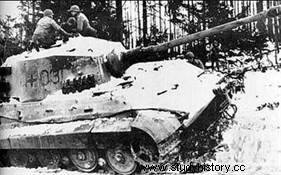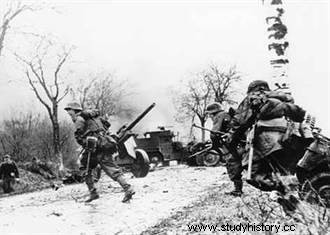 The Battle of the Bulge , from December 16, 1944 to February 1, 1945, was the last major German offensive against the Allied armies advancing towards Germany at the end of World War II. After the Normandy landings in June 1944, the Allied forces invested France but were blocked in September along the German border. On December 16, taking advantage of weather conditions that did not allow Allied planes to fly, Hitler launched a surprise counter-offensive through the Ardennes.
The Battle of the Bulge , from December 16, 1944 to February 1, 1945, was the last major German offensive against the Allied armies advancing towards Germany at the end of World War II. After the Normandy landings in June 1944, the Allied forces invested France but were blocked in September along the German border. On December 16, taking advantage of weather conditions that did not allow Allied planes to fly, Hitler launched a surprise counter-offensive through the Ardennes.
The last German counter-offensive in the West
Following the conquest of France and Belgium by the Anglo-Saxon armies, the Germans had to retreat to their fortified border in the fall of 1944. 'West along the Siegfried Line. Wanting to take advantage of the stretch of the Allied forces from Antwerp to the Swiss border, they decided to attempt a powerful counter-offensive in the Ardennes which would have enabled them, as in May 1940, to break the enemy front. This action was undoubtedly less intended to obtain a total reversal of the military situation than to delay the final Allied offensive in order to allow the Reich to put its "secret weapons" into action (rockets, jet planes, atomic bombs) , and also to cause disarray in the Western camp that could be used for diplomatic initiatives (possibly a separate peace in the West).
 The shortening of fronts to the east and west, and the year-end lull in ground combat allowed Hitler to create a reserve of nearly 300,000 men and 2,500 tanks. He decided to use them in a final offensive against the British and Americans, from the Ardennes, cutting through Belgium towards Antwerp, reusing the strategy that had worked well in 1940.
The shortening of fronts to the east and west, and the year-end lull in ground combat allowed Hitler to create a reserve of nearly 300,000 men and 2,500 tanks. He decided to use them in a final offensive against the British and Americans, from the Ardennes, cutting through Belgium towards Antwerp, reusing the strategy that had worked well in 1940.
The last battle of the Ardennes
The Germans threw into this counter-offensive, the command of which was entrusted to von Rundstedt, their best forces still available:28 divisions, including 9 armoured, supported by 1,000 hunt. Benefiting, at the beginning, from overcast weather which diminished the Allied supremacy in the air, the Germans managed to break the American front over 60 km, between Montjoie and Trier (December 16, 1944), and reached up to 10 km from the Meuse (December 25). A strategic issue, the town of Bastogne was surrounded by the Germans who sent an ultimatum to the American General McAuliffe to hand over the place. The latter will answer in a laconic way “Nuts” (nails) to this request for surrender and the American soldiers organize the defense of the city.
The heroic resistance of the Americans in Bastogne and Saint Vith and the change in atmospheric conditions allowed, from December 26, the start of the Allied counter-attack and the liquidation of this pocket . In lack of fuel, the German troops are forced to retreat. The failure of the Ardennes counteroffensive now prevented Germany from taking any strategic initiative on the western front. Managing to avoid the encirclement threatened by a pincer movement of the US Third Army commanded by Patton, the Germans fell back in January, but suffered heavy losses in equipment and men (220,000 casualties), which contributed to their defeat. the following spring.
Bibliography
- Ardennes 1944, Hitler's all-out, by Antony Beevor. the paperback, 2017.
- The Battle of the Bulge:December 16, 1944-January 31, 1945, by Guillaume Piketty. Text, 2015.
